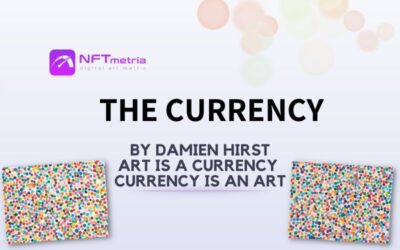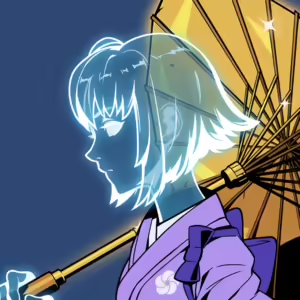Could you burn hundreds of thousands of dollars in one month? Damien Hirst, the author of The Currency collection, has burned over 4,900 physical works with a starting price of $2,000. That’s just unimaginable! And now, The Currency exists in only two worlds, the physical world and the blockchain world, which is where there’s the scarcity caused by burning physical works. All of these factors have set a very high floor price of over 3 ETH.
Damien Hirst – The Currency Official Links
- Official site https://currency.nft.heni.com
- Twitter @DamienHirst – over 5k followers,
- Instagram @damienhirst – over 943k subscribers,
- Discord @HENI – over 20k members.
What is Damien Hirst – The Currency?
The Currency collection consists of 10,000 NFTs which are located on the Ethereum blockchain and have the ERC-721 token standard.
The tokens are colored dots on a white background. It may even seem like all the works are the same, but that’s really not the case. Each work has a different density of dots on a white background, somewhere their density is less and somewhere more.

Moreover, every work in The Currency collection has a different title. 1.22% (122 pieces) of the works contain profanity in their titles.
Not all NFTs have been released on blockchain in their entirety at this time. A total of 10,000 digital copies have been made, of which 4,851 are held by users, the rest have never been released in the ERC-721 standard. There are only 1,885 NFTs in circulation on secondary markets.
Damien Hirst – The Currency in numbers
- The collection was released in July 2021 at a price of $2,000.
- Out of 10,000 pieces, only 1,885 works exist in the form of NFTs, the rest are burned and exist only in physical form.
- The total volume of secondary sales exceeded 23.5k ETH (over $41M at the current exchange rate).
- Floor price is 3.28 ETH (about $5,800).
- Average sales range from 3 ETH to 4 ETH.
- The most expensive Revocation was sold on September 10, 2021 for 51 ETH (about $164k at the time of sale).
- A total of 1,521 unique holders (81%). This shows the low chances of whales interconnection within the project. Thus, the risk of artificial project management from the inside is minimal.
- Only about 3% of the collection (62 pieces out of 1,885) are for sale, among them the offers range from 3.28 ETH to 777 ETH. This shows that almost all holders see the project as a great investment prospect and are not in a hurry to part with their assets at a lower price.
Data (including exchange rates) are given at the time of publication (March 24, 2023)
How did Damien Hirst – The Currency spread?
Arguably, The Currency collection is the most unusual distribution of art there can be. Damien Hirst, the creator of The Currency collection, came up with an original way to exchange NFTs for physical work:
- Distribution initially began in July 2021 at a cost of $2,000.
- Until July 27, 2022, users who wanted to purchase works from the collection could choose one of two options: choose a physical work made with enamel paint, or a digital work in the form of an NFT. If the user chose NFT, the physical work would literally be burned. Thus, 5,149 customers chose to purchase the physical version, while 4,851 chose to keep the NFT.
- Starting on October 12, 2022, Damien began destroying physical works in front of customers and ordinary spectators.
- On the first day, that is, October 12, the artist destroyed 1,000 works, the rest were destroyed by fire before the end of October at the Newport Street Gallery.
- The exchange of NFT works was then completed.
Thank you to all of you that attended the #BurnDay event & to those who tuned into our stream! 🔥🖼️📽️
Here are a few snaps from the day! 👇
🔴🟠🟡🟢🔵🟣
Don't forget to share your snaps/videos from the #BurnDay event using the hashtag #BurnDayLive! 📸#HENI #TheCurrency pic.twitter.com/XzMYSBWwEG
— HENI (@HENI) October 12, 2022
Who created Damien Hirst – The Currency?
The collection was created by Damien Hirst, a British artist who performs his work in the form of installations, sculpture, painting and graphics. In his works he explores the complex relationship between life and death.
His work is exhibited in the most famous exhibitions. For example, his sculptures and installations were shown at the Gagosian exhibition in London.

The artist also opened the Newport Street Gallery in London in 2015, where he burned his physical works from The Currency.
The artist began working on The Currency collection back in 2016. He created all 10,000 of the original physical works himself, by hand, without the use of computer technology. He was motivated to bring his work to life in NFT form by technology which captured his attention and got him interested in this field.
Why is Damien Hirst – The Currency popular?
There are several factors that influenced both the price and the popularity of the collection:
- Damien’s own fame added value to the collection. He is considered one of the most appreciated artists in the world, and his works are exhibited in the most famous exhibitions.
- The uniqueness of the works, which are drawn entirely by hand and balance between the physical world and the blockchain.
- The uncommonness of exchanging the NFT collection for physical works, which resulted in physical works digitized as NFTs being destroyed. This adds value to NFT works, as they can no longer be restored on canvas.
- A limited number of works that balance between the physical and digital worlds.
Damien Hirst – The Currency Idea
The Currency’s works explore the boundaries of art and currency:
- When Art Changes and Becomes Currency,
- When Currency Becomes Art.
This is the first concept that reflects the model of the NFT market and that of collecting.
That is, when a work is in the user’s possession, it is art; when a work is for sale, it is currency. In the NFT space, one or another collection is primarily seen as an investment, and only then as art when it is already in someone’s wallet.
The artist also laid down the concept, that is, a physical canvas or NFT. Damien believes that the same work cannot exist simultaneously on a physical medium and as an NFT. Therefore, he chose a very unusual way of sharing the NFT of his art by burning those works on a physical medium that users chose as NFT. In this way, the artist aligned his collection between blockchain and physical space.
Damien Hirst – The Currency Roadmap
The Currency has no roadmap.
The Currency is an artwork, and anyone who buys it will participate in this work, it’s not just about owning it. It is the most exciting project I have ever worked on by far. Here is what Damien Hirst says about the prospects of the project
Damien Hirst – The Currency Ecosystem
The NFT collection does not have any use, and therefore the project does not have an ecosystem.
How much do Damien Hirst – The Currency NFTs cost?
Distribution of the works from the collection began in July 2021 at a price of $2,000. That same month, the collection began trading on secondary markets, where there was great demand for it. And how are things in terms of pricing?
To visualize the price dynamics, we made a slice of the average price for 1 NFT:
- In October 2021: 6.3 ETH;
- In February 2022: 4.2 ETH;
- In June 2022: 6.1 ETH;
- In October 2022: 3.9 ETH;
- In February 2023: 2.8 ETH.
At the moment, on March 24, 2023, the floor price is 3.28 ETH (about $5,800). On average, the latest sales of NFTs range from 3 to 4 ETH. And the total volume of secondary sales amounted to more than 23.5k ETH (about $41 million at the moment).
The Most Expensive Sales of Damien Hirst – The Currency
The most expensive sales are led by the following NFTs from the Damien Hirst – The Currency NFT collection:
- Revocation was sold on September 10, 2021 for 51 ETH (about $164k at the time of sale).
- Can’t you just be as sweet as she says was sold on August 31, 2021 for 40 ETH (about $137k at the time of sale).
- You’re the reason I had to move in was sold on August 31, 2021 for 35 ETH (about $120k at the time of sale).
- Adrift was sold on August 31, 2021 for 35 ETH (about $113k at the time of sale).

Where to buy Damien Hirst – The Currency?
Currently, Damien Hirst – The Currency can only be purchased on the secondary market, on NFT marketplaces such as OpenSea, X2Y2 and LooksRare.
How to buy Damien Hirst – The Currency?
- Remember that initially you need to connect your crypto wallet with self-storage to the marketplace of your choice.
- Next, find the official collection using the search bar on the marketplace.
- Analyze and choose the NFT you want to buy; click on it and then on the “Buy” button.
- Or you can bet on the token you like. Make sure you leave enough ETH for gas or transaction fees. If the seller approves your bid, the deal goes through.
Should you invest in Damien Hirst – The Currency?
There are several things that make The Currency collection look pretty positive:
- The floor price of the collection on the secondary markets is almost 3 times the distribution price.
- The value of the NFT works is increased in the absence of a physical original.
- All of the pieces were handmade by the artist and took about 6 years to complete.
- Floor price of the collection has never fallen below the distribution price of the collection.
Remember that investing in this collection can be long-term and you should always do your own analysis before investing in an NFT project.
Opinion of NFTmetria
Damien Hirst – The Currency is a collection by British artist Damien Hirst that is one of the most unique ones. Its uniqueness is that it balances between the physical world and the blockchain, which makes it one of the most valuable works of art. The hand-drawn works caused a stir, and even more excitement was caused by the burning of works that had been digitized as NFTs. Hundreds of thousands of dollars were burned by Damien himself, giving rise to the unique art called The Currency.











